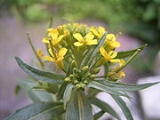
Erysimum cheiranthoides
Encyclopedia
Erysimum cheiranthoides (Treacle-mustard) is a species of Erysimum
native to most of central and northern Europe
and northern and central Asia
.
It is a herbaceous
annual plant
similar in appearance to many other mustards, growing an erect stem 15–100 cm (rarely 150 cm) tall. The leaves
are lanceolate
to elliptic
, 2–11 cm long and 0.5–1 cm broad, with an entire to coarsely toothed margin. The flower
s are bright yellow, 5–12 mm diameter, produced in an erect inflorescence
. The fruit
is a slender cylindrical capsule
1–3 cm (rarely 5 cm) long, containing several small, dark brown seeds.
It is widely naturalised
outside of its native range, including in western and southern Europe, and North America.
Wallflower
Erysimum is a genus that includes about 180 species, both popular garden plants and many wild forms. The genus Cheiranthus is sometimes included herein whole or in part. Erysimum has recently adscribed to a monogeneric cruciferous tribe, Erysimeae...
native to most of central and northern Europe
Europe
Europe is, by convention, one of the world's seven continents. Comprising the westernmost peninsula of Eurasia, Europe is generally 'divided' from Asia to its east by the watershed divides of the Ural and Caucasus Mountains, the Ural River, the Caspian and Black Seas, and the waterways connecting...
and northern and central Asia
Asia
Asia is the world's largest and most populous continent, located primarily in the eastern and northern hemispheres. It covers 8.7% of the Earth's total surface area and with approximately 3.879 billion people, it hosts 60% of the world's current human population...
.
It is a herbaceous
Herbaceous
A herbaceous plant is a plant that has leaves and stems that die down at the end of the growing season to the soil level. They have no persistent woody stem above ground...
annual plant
Annual plant
An annual plant is a plant that usually germinates, flowers, and dies in a year or season. True annuals will only live longer than a year if they are prevented from setting seed...
similar in appearance to many other mustards, growing an erect stem 15–100 cm (rarely 150 cm) tall. The leaves
Leaf
A leaf is an organ of a vascular plant, as defined in botanical terms, and in particular in plant morphology. Foliage is a mass noun that refers to leaves as a feature of plants....
are lanceolate
Leaf shape
In botany, leaf shape is characterised with the following terms :* Acicular : Slender and pointed, needle-like* Acuminate : Tapering to a long point...
to elliptic
Leaf shape
In botany, leaf shape is characterised with the following terms :* Acicular : Slender and pointed, needle-like* Acuminate : Tapering to a long point...
, 2–11 cm long and 0.5–1 cm broad, with an entire to coarsely toothed margin. The flower
Flower
A flower, sometimes known as a bloom or blossom, is the reproductive structure found in flowering plants . The biological function of a flower is to effect reproduction, usually by providing a mechanism for the union of sperm with eggs...
s are bright yellow, 5–12 mm diameter, produced in an erect inflorescence
Inflorescence
An inflorescence is a group or cluster of flowers arranged on a stem that is composed of a main branch or a complicated arrangement of branches. Strictly, it is the part of the shoot of seed plants where flowers are formed and which is accordingly modified...
. The fruit
Fruit
In broad terms, a fruit is a structure of a plant that contains its seeds.The term has different meanings dependent on context. In non-technical usage, such as food preparation, fruit normally means the fleshy seed-associated structures of certain plants that are sweet and edible in the raw state,...
is a slender cylindrical capsule
Capsule (fruit)
In botany a capsule is a type of simple, dry fruit produced by many species of flowering plants. A capsule is a structure composed of two or more carpels that in most cases is dehiscent, i.e. at maturity, it splits apart to release the seeds within. A few capsules are indehiscent, for example...
1–3 cm (rarely 5 cm) long, containing several small, dark brown seeds.
It is widely naturalised
Naturalisation (biology)
In biology, naturalisation is any process by which a non-native organism spreads into the wild and its reproduction is sufficient to maintain its population. Such populations are said to be naturalised....
outside of its native range, including in western and southern Europe, and North America.

